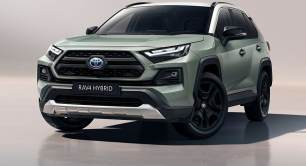The RX is a five-seat only proposition in this generation - the previous model had a seven-seat option - so if you need a third row you can look at the Lexus LM people mover or massive LX 4x4 SUV, or at any number of other three-row lux SUVs like the Volvo XC90 or new Mazda CX-90.
That doesn’t mean the cabin isn’t practical.
Up front the seats offer excellent comfort levels and ample upper body support, but not a lot of hip support.
Lexus has changed up the door handles for the new RX and it can be complicated - initially.
The interior handles bamboozled every new person that got in my press car over the three week loan. But once you realise it’s a simple push of the thumb on the handle’s thumbpad and a gentle push, it all makes sense.
Lexus calls the electrically activated door handles an ‘e-latch’. Is it tech for tech’s sake? Probably.
I recently reviewed the Lexus LM and commented on how much I like Lexus steering wheels and that’s true of the RX, too.
It has clearly identifiable controls and feels nice in your hands. Thankfully, the cruise control buttons are housed on the wheel too, so no annoying stalk on the wheel.
There’s plenty of space across the front row so you should avoid the awkward driver-passenger elbow bump on the centre armrest.
Under the armrest is a huge central bin that opens on the driver and passenger side. There’s also a big covered storage nook forward of the shifter and another ledge above that, as well as a sizeable glove box.
The doors have ample storage room for bottles, but the space is almost too wide. My bottle slid around when driving so I had to lay it down.
The centre console houses two big cupholders with adjustable depth in one of them. Clever touches like this and the central bin add to the appeal.
As with the Lexus LM, I am a fan of the new Lexus multimedia set-up. It has an easy-to-navigate menu along the side, easy wireless Apple CarPlay connection, and visually appealing graphics.
It’s a world away from Lexus’ previous system. That frustrating touchpad is, thankfully, in the bin.
I quite like the gear shifter with its unusual gate and even the indicator feels and sounds premium.
Small rear windows make for a rear three quarter blind spot, but visibility is otherwise good.
On a side note, the RX has very strong air conditioning - perfect for an Australian summer.
Jumping into the second row, there’s plenty of space all around and no shortage of head, leg, knee and shoulder room. Although foot room under the front seats is tight.
As with the front seats, the rear row offers comfortable seating. Kids should be happy back there.
There’s only a small transmission tunnel so middle-seat legroom is good. And in great news for passengers, the rear backrests recline.
Lowering the 40/20/40 split-fold rear seats for more cargo space is done via a lever on the side of the outboard seats, or by a button in the boot area. There are ISOFIX clips on the two outboard seats.
Other amenities in the second row include map pockets, two USB-C ports, knee-level air vents, climate control, and a pull-down armrest with pop-open cupholders.
Open the power tailgate and you’ll find cargo space of 612 litres with all seats in place, or 1678L with the second row stowed.
That’s a decent amount of space but not class leading. The Mercedes-Benz GLE has 630L and the VW Touareg can swallow 810L.
There’s no under-floor storage because that’s where some hybrid hardware is housed. You will find audio speakers, nice carpet, a cargo blind, two 4.0kg hooks and three top tethers. No spare, only a tyre repair kit.

